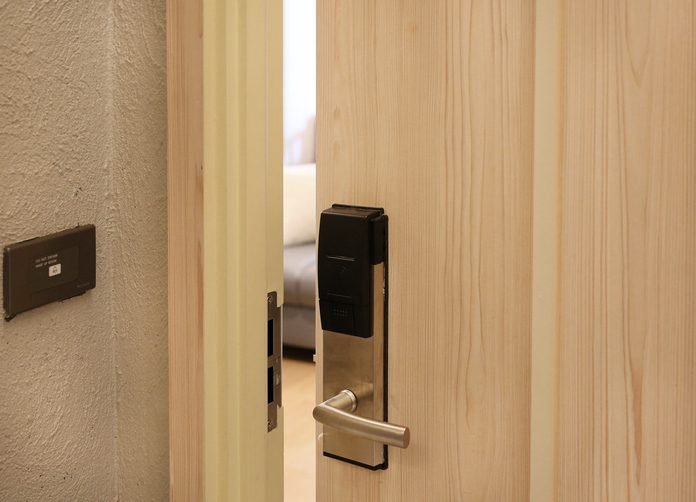
Guests often consider a hotel’s amenities when choosing a place to stay. Hotel door locks are an overlooked amenity that have a big impact on the guest experience. Guests can misplace keys and cards, causing them to visit the front desk for new ones, sometimes having to pay a fee for lost keys. Locking technologies available on the market make hotel manager’s jobs easier, and guests can have a more relaxing experience.
Radio Frequency Identification (RFID) Locking Systems
Locks with RFID sensors started appearing in hotels in the early 2000s, and made door unlocking easier than the traditional magnetic stripe. Instead of inserting the card into the slot reader on the door’s lock, RFID cards are simply held up to the lock. The lock contains an RFID reader that recognizes the designated card and unlocks the door.
One major benefit of using RFID cards and locks is that the locks were specifically designed to eliminate the problems of magnetic stripe locks, including when the magnetic stripe is damaged or scratched, which prevents the reader from unlocking the door. RFID cards prevent those pain points by embedding RFID sensors inside the card, making it more difficult to damage. Hotels can also reuse RFID cards. However, the downside of RFID cards is the cost; a hotel can spend upwards of one thousand dollars per month replacing stolen, misplaced, or lost cards.
Bluetooth Low Energy (BLE) Locking Systems
Bluetooth technology for locking systems began in 2014 in the form of mobile keys. Mobile keys are downloaded onto guests’ smartphones and are accessed through an application. Guests simply hold their smartphone up to the sensor on their door, which reads the encrypted key and unlocks the door. BLE locking systems were first used by the Hilton and Marriott brand families.
BLE locking systems have many benefits, like long battery life. The locking sensors last for 12 to 18 months without a charge, allowing for less maintenance. Most BLE locking system brands use a 128-bit encryption security system, keeping guests safe at a hotel. Hotels don’t have to replace cards or keys with BLE systems, which saves money long-term. There are few downsides to BLE locking systems. Guests were originally reluctant to download a hotel’s application on their phone to access digital keys. However, this has changed in recent years, with more guests owning smartphones and becoming familiar with the technology.
Full-Body or Unibody Locks
Full-body or unibody locks are built into and installed on the guestroom door, and they include a reader and door handle within one structure. Most full-body locks are made from stainless steel and come in a variety of colors and finishes. Full-body locks have the battery supply stored at the back of the lock for easy recharging. The primary benefits of full-body locks include easy installation and minimal modifications to the door for installation; it is also simple to upgrade to a full-body lock from a magnetic stripe lock because they have a similar shape and surface area. Full-body locks, though, need to be reset after every guest and are sometimes finicky when installing during initial setup.
Hotel managers and owners need to keep hotel guests safe. Smart locking systems provide an extra layer of safety for guests and can improve a hotel’s bottom line. Managers and owners need to understand the needs of typical hotel guests and their level of comfort with technology. Knowing guests’ demographics can help managers and owners decide on the locking systems that will work best for their hotels.











